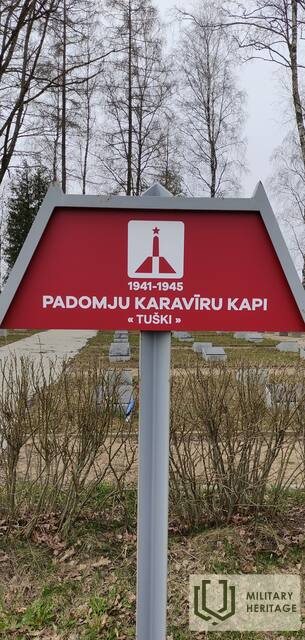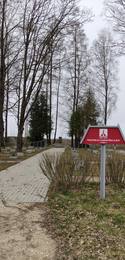Exhumation of Soviet Army soldiers in Blīdene parish in 2019
In July 2019, the Soldiers' Search Team "Leģenda" exhumed 66 soldiers' ashes in a forest in Blīdene parish. Due to superficiality or omission during the Soviet era, the majority of these soldiers are counted as officially reburied during the Soviet years. The names of these soldiers are even engraved on the tombstones in the Tuški Brethren Cemetery.
In July 2019, the soldier search unit “Legend” found and exhumed the ashes of 66 soldiers who had been lying in the forest in Blīdene parish for 74 years, although their names can be read on the gravestones in the Tuški cemetery. Due to negligence or inaction, which was allowed during the Soviet era, the scar of war has not been torn open again in a single family.
The search unit men worked in the area where the Guļauce forester's house was located during World War II. Now it is a forest. But at that time, a Red Army sanitary unit was established, and the fallen were buried next to it at the edge of the forest.
The found are soldiers of the 308th Latvian Rifle Division. About 85% of them were drafted into the Red Army from the territories of Latvia at the end of 1944. They are mainly Latvians. An unpleasant surprise awaited the searchers. Most of these soldiers are considered to have been officially reburied during the Soviet years. The names of these soldiers are even engraved on the gravestones in the Tuški Brothers Cemetery.
"That first shock was incomprehensible. Because we knew that he had been reburied in the Tuški cemetery. We went every year to commemorate our brother," says Ella Indzere, the sister of Arvīds Popovs, who fell in the war.
Ella Indzera and Zidrīte Paula's older brother Arvīds Popovs did not return from the war. Arvīds Popovs was at the front for only a month and a half.
“It was the fall of 1944 when the Red Army entered Latvia. The Kurzeme cauldron was boiling. They had already come as far as Auce,” Ella recalls.
"He was 19. I was 17. We were standing at the gate, dad, mom, me. We waved. He looked back and left, and never came back. And then there was a summons that he had fallen," adds Zidrīte Paula.
“I remember the third letter, which I read myself years later. He wrote: “Mommy, the war will end soon, and I will walk home from Blīdene.” That sentence has remained very close to my heart. When he left, he picked me up, the girl, showed me the lights and said – sister, wait for me at home,” Ella continues.
The sisters keep the yellowed notice with the mournful message that their brother died of wounds on March 5, 1945, while at the front, showing manliness and heroism in battle with the German invaders. It is indicated that he was buried in grave site no. 7 at the forest edge near the Guļauce house in Blīdene district. Later, during the Soviet years, the family was informed that Arvīds was reburied in the Tuški brothers' cemetery.
https://www.sargs.lv/lv/otrais-pasaules-kars/2020-06-21/tusku-bralu-kapos-gulda-66-karaviru-pislus
https://www.lsm.lv/raksts/zinas/latvija/atrasti-66-kara-kritusi-karaviri-kuriem-bija-jadus-kapseta.a329053/
Related timeline
Related objects
Soviet soldiers' cemetery "Tuški"
The fraternal cemetery of the Red Army 130th Latvian and 8th Estonian Rifle Corps soldiers is located about 350 metres south-west of the Blīdene-Remte road. The name derives from the farm Tušķi, which was located 400 m south of the cemetery.
On 17 March 1945, the last attempt of the Red Army in Kurzeme began. The 308th Latvian Rifle Division attacked south-west and west of the Tušķi homestead and during three days of fighting crossed the Blīdene-Remte road in the 142.2 area of the highlands and reached the Jaunāsmuižas-Mezmali line. The soldiers killed during the battles were buried in several small cemeteries near Ķēķiai, Vērotāji, Jaunāsmuiža and elsewhere.
In the late 1960s, when the Soviet Union began to commemorate the Second World War, a new cemetery was established north of the ruins of the Tušķu homestead, where it was planned to rebury all the soldiers who had fallen in the Pilsblidene and Kaulači area. In reality, the reburial was partial, as very often the fallen soldiers remained in their original gravesites, but only their names were overwritten in the cemetery of the Tuški brothers. The names of the soldiers of the 8th Estonian Rifle Corps, whose main wartime cemetery was located on the site of the present Pilsblidene cemetery, can also be found in the Tuški Brethren Cemetery.
There is also a monument to Jakob Kundera, a soldier of the 8th Estonian Rifle Corps, to whom the object 'Kundera dots' is dedicated. Immediately after the battle, Jakob Kundera was buried in what is now Pilsblidene Cemetery, and later reburied in the Tuški Brethren Cemetery.






